Table of Contents
- The Fuse Network and how it works
- Fuse Wallet SDK and Bitazza’s Freedom Wallet
- Fuse Bridges and Token Bridge
- Staking FUSE to become a delegator and earn rewards
Blockchain and DeFi have cemented themselves and are steadily moving towards mass adoption — in Wall Street, that is. With the launch of the Bitcoin and Ethereum ETFs, it’s easier than ever for a person to invest in crypto, but usage is another matter.
With the original premise of blockchain being used for commerce and payments, very few projects are focusing on that today. Fuse.io is the exception, posting tremendous growth as it focuses on a number of payment-heavy use cases.
Launched in 2019 as a decentralized, blockchain-powered platform, Fuse.io aims to bring the DeFi to the masses and to simplify crypto payments. It achieves this by operating as a middleware layer that offers relay services and enables gasless transactions for merchants and users.
Having recently recorded over 1,000,000 user wallets amid steadily growing transaction activity on its chain, Fuse Network is quietly fulfilling its mission. Unlike some of the flashiest names of today’s crypto space, Fuse focuses on real world activity — an approach that in the long run beats short term hype from celebrity memecoins.
The Fuse Network and how it works
The Fuse Network is made of various components, starting with the Fuse blockchain and extending to a mobile-centric open-source technology stack and a dedicated SDK for DeFi products and tools.
The Fuse Network Blockchain, which powers the Fuse Platform and its entire ecosystem, is a decentralized, EVM-compatible public blockchain that utilizes various forms of delegated Proof-of-Stake (dPoS) consensus.
In this consensus mechanism, the network consists of multiple nodes and validators that operate in turn, with one validator continuously managed by the core team. This system ensures very high-speed and highly scalable transactions: Fuse can process hundreds of transactions per second and the average time to confirm a block on Fuse is around 5 seconds with minimal costs of less than a penny.
At the same time, this mechanism maintains a decentralized and democratic environment: delegates are accountable to the community of stakeholders, and everyone has the opportunity to become a validator.
Fuse Wallet SDK and Bitazza’s Freedom Wallet
On the path to increase blockchain adoption and facilitate crypto payments for users while enhancing trust for merchants, the Fuse Wallet SDK is specifically designed to facilitate developers to create blockchain apps for commerce.
The Software Development Kit (SDK) serves as a valuable resource for businesses, including e-commerce platforms, looking to explore cryptocurrency trading. With this kit, Fuse aims to simplify the integration of cryptocurrency payments into mobile apps and the development of custom mobile wallets.
One noteworthy example of leveraging the FuseBox developer toolkit is the Freedom Wallet developed by Bitazza, a longstanding partner of Fuse.
Bitazza’s Freedom Wallet is designed to offer users the most intuitive, non-custodial mobile wallet experience for seamless cryptocurrency transactions both online and offline. This is made possible through the efficient and cost-effective technology provided by Fuse, along with Visa's prepaid card integration. The user-friendly interface of the Freedom Wallet App owes much to Fuse's Mobile Wallet SDK, which facilitates the delivery of a smooth and intuitive end-user experience.
Fuse Bridges and Token Bridge
Another vital component that streamlines crypto payments and simplifies the DeFi environment is the capability to seamlessly move assets from one chain to another. As an integral part of Fuse’s mission, the blockchain platform offers bridges to transfer funds and NFTs across different networks.
Moreover, Fuse recently launched a beta version of a token bridge in collaboration with LayerZero. The token bridge is safeguarded by Web3 security experts IronBlocks and it aims to enhance interoperability of FUSE, USDC, and WETH between Fuse Network, Polygon, Optimism, and Arbitrum.
Staking FUSE to become a delegator and earn rewards
The Fuse Network is underpinned by its staking mechanism, which allows users and maintainers of the network to benefit from its growing adoption, strategic partnerships and innovative products.
Any FUSE holder can delegate their stake to existing validators, or go through the election process themselves. Both processes are very simple to do, thanks to the Fuse Staking Dapp.
With its growing user base, innovative products, and strategic collaborations, Fuse.io is making significant strides in integrating blockchain technology into modern finance. By offering user-friendly solutions and enhancing network interoperability, Fuse.io addresses the limitations of traditional banking systems and complex DeFi protocols.
Though Fuse’s focus may not be as immediately noticeable as the usual flashy crypto narrative, focusing on the fundamentals sets it up nicely for attracting a real user base who is benefiting from crypto beyond its use for trading. With its commitment to ongoing development and community-driven growth, Fuse.io is poised to play a pivotal role in the future of decentralized finance.
Disclaimer: This article is provided for informational purposes only. It is not offered or intended to be used as legal, tax, investment, financial, or other advice.












